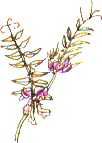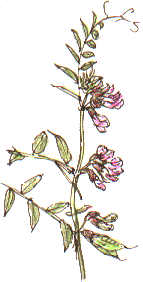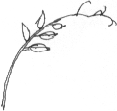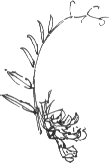 
TendrilThursday 13th July 2000 TODAY; 'HOW TO DRAW TENDRILS', or, rather, how not to draw them. I've picked a piece of Bush Vetch; a wildflower of grassy and bushy places, which grows as a weed in our garden. Much as I like drawing from life, in practice almost every sketch in this diary has been drawn from memory. I wouldn't normally pick any wildflower. But drawing from the actual specimen is a different process to drawing from an idealised image that is in my mind. Here are the stages I went through. I'm not suggesting that this is how you should do it, but you might learn something from my mistakes;  1. I lay the flower on a piece of white paper then start my sketch. I'm intending to draw it rather smaller than life-size, so I start at the top right of my sketchbook page.
1. I lay the flower on a piece of white paper then start my sketch. I'm intending to draw it rather smaller than life-size, so I start at the top right of my sketchbook page.2. I'm right-handed and, being English, I write from write from left to right across the page. If I was left-handed (like, say, Leonardo da Vinci) or Japanese, I might find it natural to work down the page diagonally left to right. But I'm not. It doesn't feel comfortable and the tendril I'm drawing (right) turns out wobbly, not even the right shape. It doesn't look as if it's alive and growing.  3. I start again and try to draw the springy tendril in a freer, less controlled manner (left). One quick line going up, then one down. No, I'm way out with the shape. There's a kink in it, it's not flowing like the real live plant.
3. I start again and try to draw the springy tendril in a freer, less controlled manner (left). One quick line going up, then one down. No, I'm way out with the shape. There's a kink in it, it's not flowing like the real live plant. 4. My third attempt (right). A rather more careful line for the tendril. Hmmm, not bad for the basic shape. Then I draw in the flowers, the end of the tendril and those leaflets arranged along the stem, being careful to get the proportion right for the intervals between the leaves. No, I've got it wrong again; I've drawn the tendril too short to fit all the leaves on, if I'm going to keep them in proportion with the flower. I never have this problem when I'm working from memory; when I do that I'm already working from a simplified, minds-eye version.
4. My third attempt (right). A rather more careful line for the tendril. Hmmm, not bad for the basic shape. Then I draw in the flowers, the end of the tendril and those leaflets arranged along the stem, being careful to get the proportion right for the intervals between the leaves. No, I've got it wrong again; I've drawn the tendril too short to fit all the leaves on, if I'm going to keep them in proportion with the flower. I never have this problem when I'm working from memory; when I do that I'm already working from a simplified, minds-eye version. 5. So in the final version. I tell myself to relax - that's important to remember after all these false starts. I draw the basic shape of the flowers first then let the tendril grow upwards from the flowers. It's the same with the other leaves; start from the main stem and draw outwards, as if I'm growing with the plant.
5. So in the final version. I tell myself to relax - that's important to remember after all these false starts. I draw the basic shape of the flowers first then let the tendril grow upwards from the flowers. It's the same with the other leaves; start from the main stem and draw outwards, as if I'm growing with the plant.If you've ever read Frederick Franck's The Zen of Seeing, you'll be familiar with this mind-set for drawing. Relaxed but alert, and letting yourself get into the subject. He suggests that when you draw a tree, you let yourself grow with the tree. Japanese artists would spent long periods just looking at, say, bamboo, or fish swimming. They'd practice drawing leaves, spines or tendrils until it became second nature to them to produce spiky or flowing brushstrokes. Media; I used a Rotring Art Pen with an extra fine sketch nib, filled with Waterman brown fountain pen ink. This is water soluble so, instead of watercolours, I added the colour using Derwent artist's quality Watercolour Pencils (applied dry). Admittedly, with all those false starts, it might have been easier to use a pencil, starting with a faint line until I was happy with the proportions. But I like the decisiveness of drawing in pen and ink, and my training was in graphic design, so I prefer the 'graphic' quality of pen and ink to the softness of pencil. Wall Spider I've seen that same species of spider again today. It was running about on the sunny house wall near the front door by the cotoneaster. The flattened body, that I assumed was to help it move in confined spaces could equally be to keep its centre of gravity close to the wall and to minimise the shadow that it casts, making it more difficult for predators, such as birds and wasps, to pick out its outline.
I've seen that same species of spider again today. It was running about on the sunny house wall near the front door by the cotoneaster. The flattened body, that I assumed was to help it move in confined spaces could equally be to keep its centre of gravity close to the wall and to minimise the shadow that it casts, making it more difficult for predators, such as birds and wasps, to pick out its outline. There is a small predator out on the prowl when I go out to pick the bush vetch, after sunset this evening; a small Toad hops along by the courgettes. It's not such an athletic hopper as the frog. Hope it keeps down those slugs.
There is a small predator out on the prowl when I go out to pick the bush vetch, after sunset this evening; a small Toad hops along by the courgettes. It's not such an athletic hopper as the frog. Hope it keeps down those slugs.
|